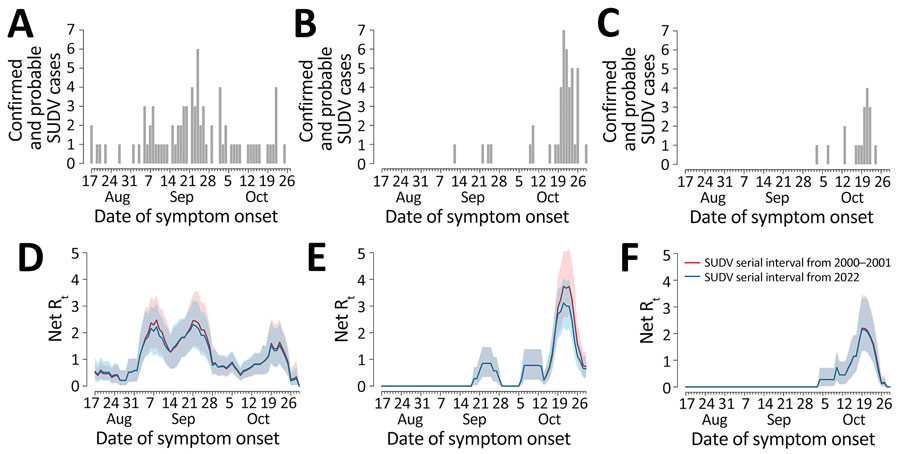Volume 29, Number 7—July 2023
Dispatch
Estimates of Serial Interval and Reproduction Number of Sudan Virus, Uganda, August–November 2022
Figure 1

Figure 1. Epidemic curves and reproduction numbers for SUDV outbreaks in Mubende, Kassanda, and Kampala districts, Uganda, August–November 2022. A–C) Number of confirmed and probable cases by date of symptom onset in the 3 considered districts (comprising 95% of cases reported in the whole country, as of November 2, 2022) (2): Mubende (A), Kassanda (B), and Kampala (C). D–F). Estimates of the net reproduction number over time in the 3 districts: Mubende (D), Kassanda (E), and Kampala (F). Estimated from the corresponding epidemic curves by date of symptom onset were computed using the serial interval distributions from the 2000–2001 outbreak (5) (red) and the 2022 outbreak (6) (blue). Shaded areas represent 95% CIs of estimates. We assumed that the first case of the epidemic curve in each district was imported and that all the others were locally transmitted. SUDV, Sudan virus.
References
- World Health Organization–Uganda. Uganda declares Ebola virus disease outbreak. 2022 [cited 2023 Jun 6]. https://www.afro.who.int/countries/uganda/news/uganda-declares-ebola-virus-disease-outbreak
- Republic of Uganda Ministry of Health, World Health Organization–Uganda. Ebola virus disease—situation report 42 [cited 2023 Jun 6]. https://www.afro.who.int/sites/default/files/2022-11/Ug_EVD_SitRep%2342.pdf
- European Centre for Disease Prevention and Control. Ebola disease outbreak caused by Sudan ebolavirus in Uganda, 2022—9 November 2022 [cited 2023 Jun 6]. https://www.ecdc.europa.eu/sites/default/files/documents/ebola-risk-sudan-virus-considered-very-low-risk-assessment.pdf
- Republic of Uganda Ministry of Health, World Health Organization–Uganda. Ebola virus disease—situation report 93 [cited 2023 Jun 6]. https://www.afro.who.int/sites/default/files/2023-01/Ug_EVD_SitRep%2393.pdf
- Francesconi P, Yoti Z, Declich S, Onek PA, Fabiani M, Olango J, et al. Ebola hemorrhagic fever transmission and risk factors of contacts, Uganda. Emerg Infect Dis. 2003;9:1430–7. DOIPubMedGoogle Scholar
- Republic of Uganda Ministry of Health. Press statement. Update on the Ebola virus disease outbreak and containment measures. 26 October, 2022 [cited 2023 Jun 6]. https://www.health.go.ug/cause/update-on-the-ebola-virus-disease-outbreak-and-containment-measures
- Cori A, Ferguson NM, Fraser C, Cauchemez S. A new framework and software to estimate time-varying reproduction numbers during epidemics. Am J Epidemiol. 2013;178:1505–12. DOIPubMedGoogle Scholar
- Chowell G, Hengartner NW, Castillo-Chavez C, Fenimore PW, Hyman JM. The basic reproductive number of Ebola and the effects of public health measures: the cases of Congo and Uganda. J Theor Biol. 2004;229:119–26. DOIPubMedGoogle Scholar
- Chowell G, Viboud C, Simonsen L, Moghadas SM. Characterizing the reproduction number of epidemics with early subexponential growth dynamics. J R Soc Interface. 2016;13:
20160659 . DOIPubMedGoogle Scholar - Parag KV. Improved estimation of time-varying reproduction numbers at low case incidence and between epidemic waves. PLOS Comput Biol. 2021;17:
e1009347 . DOIPubMedGoogle Scholar - Van Kerkhove MD, Bento AI, Mills HL, Ferguson NM, Donnelly CA. A review of epidemiological parameters from Ebola outbreaks to inform early public health decision-making. Sci Data. 2015;2:
150019 . DOIPubMedGoogle Scholar - World Health Organization. Ebola disease caused by Sudan Ebola virus—Uganda. 2022 [cited 2023 Jun 6]. https://www.who.int/emergencies/disease-outbreak-news/item/2022-DON421